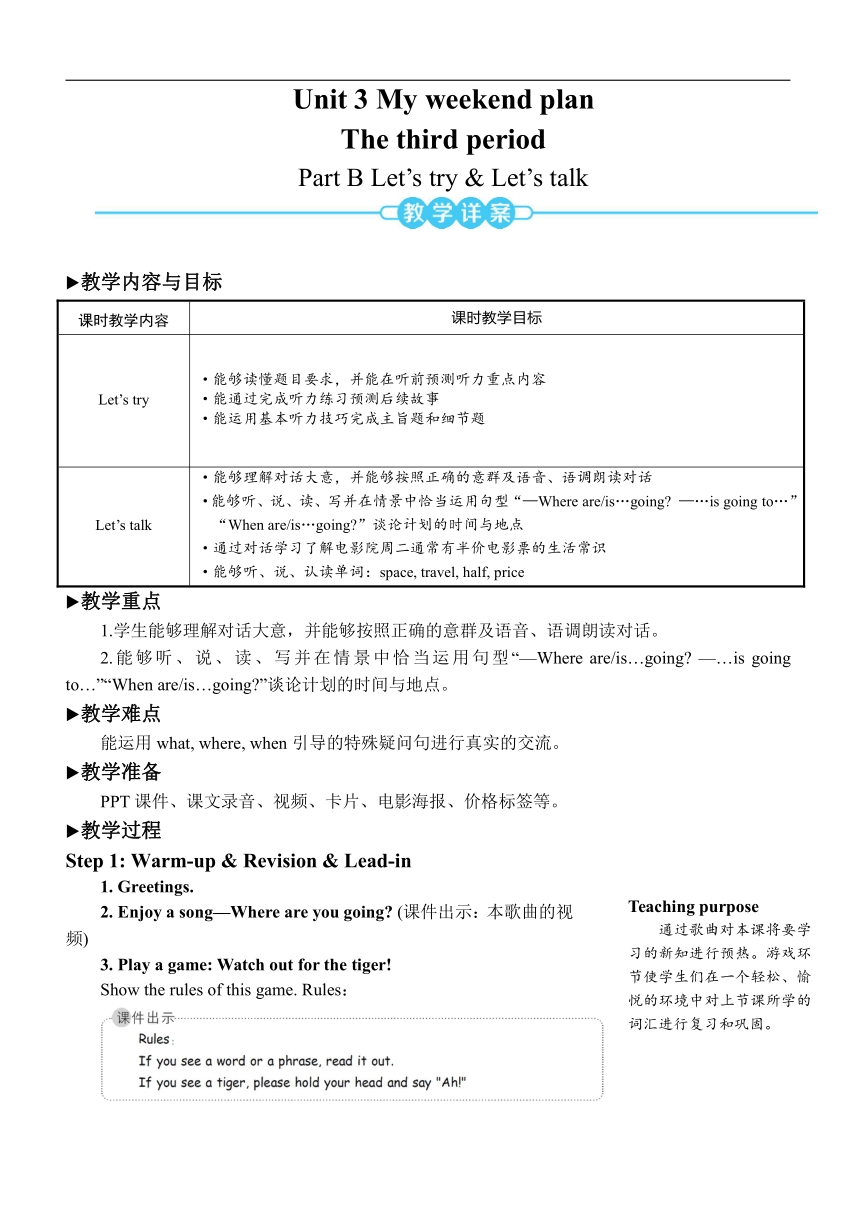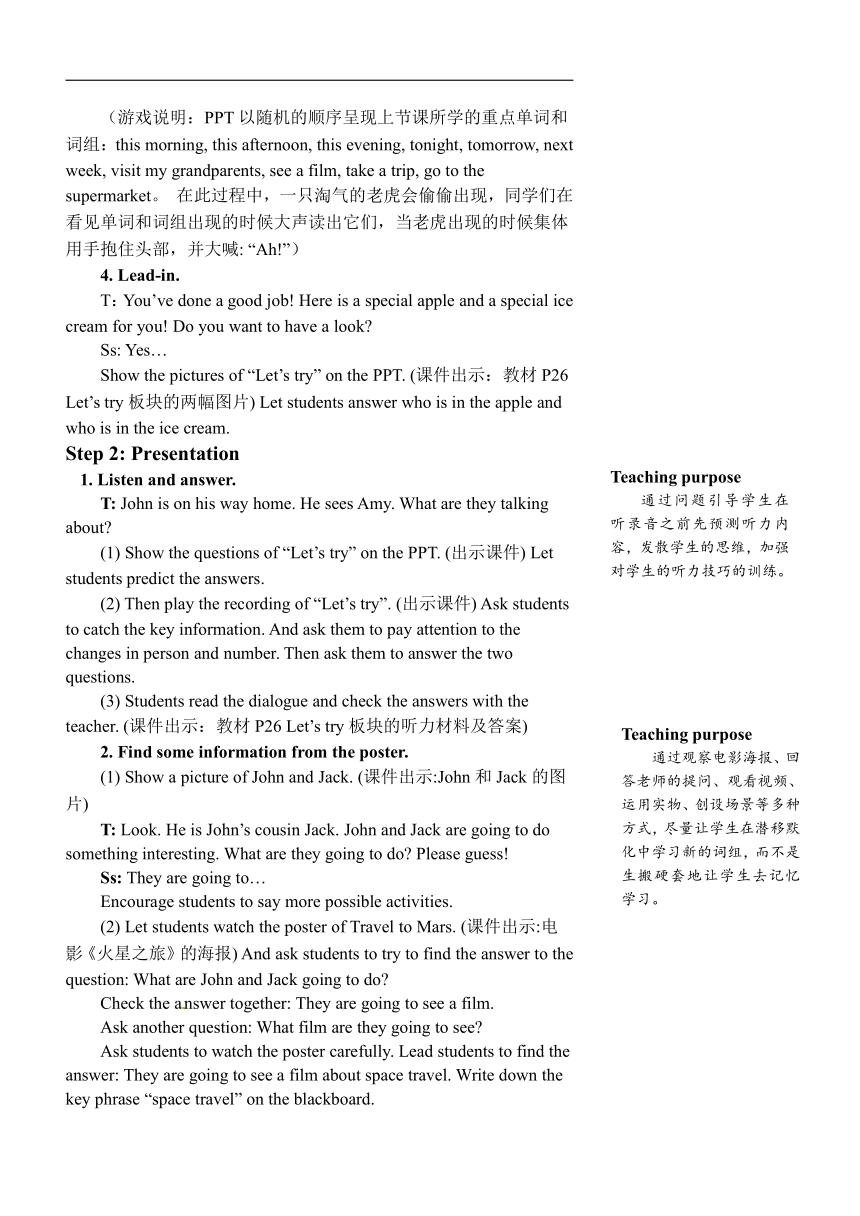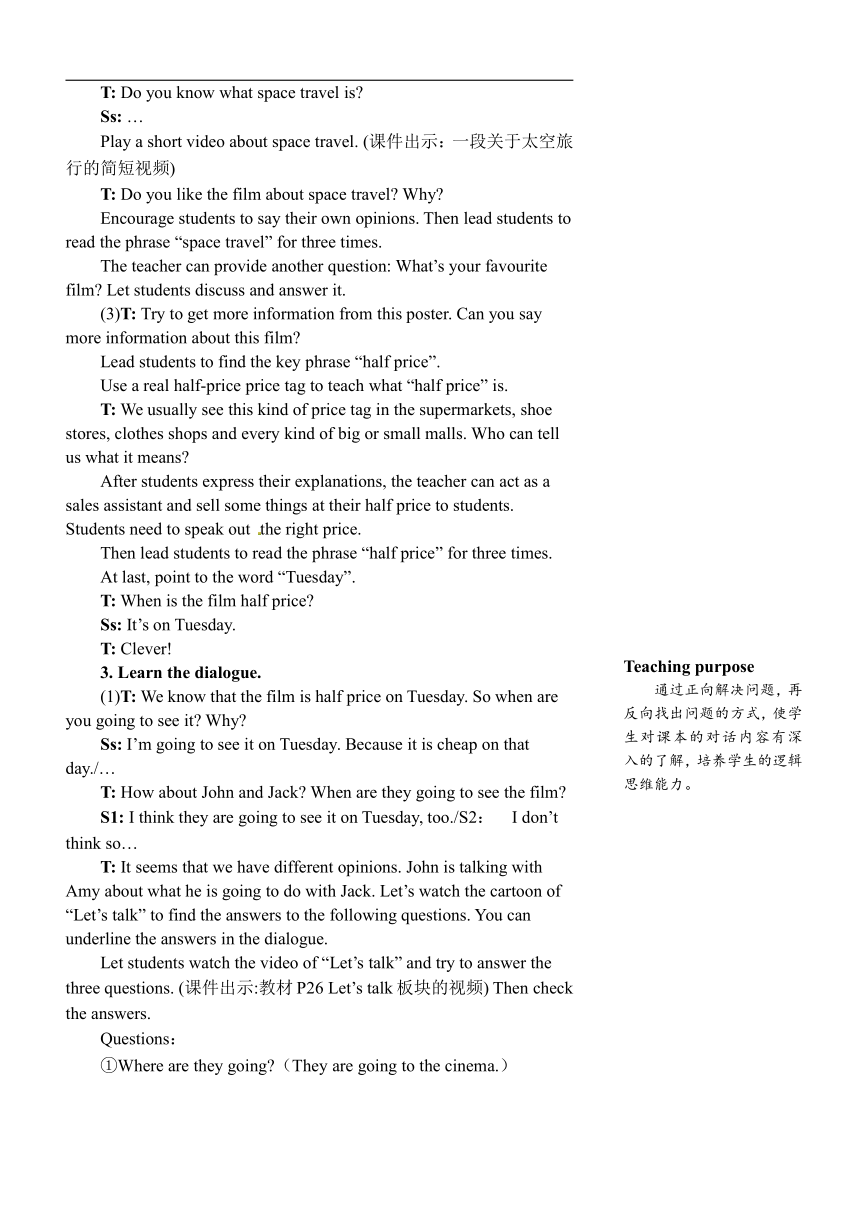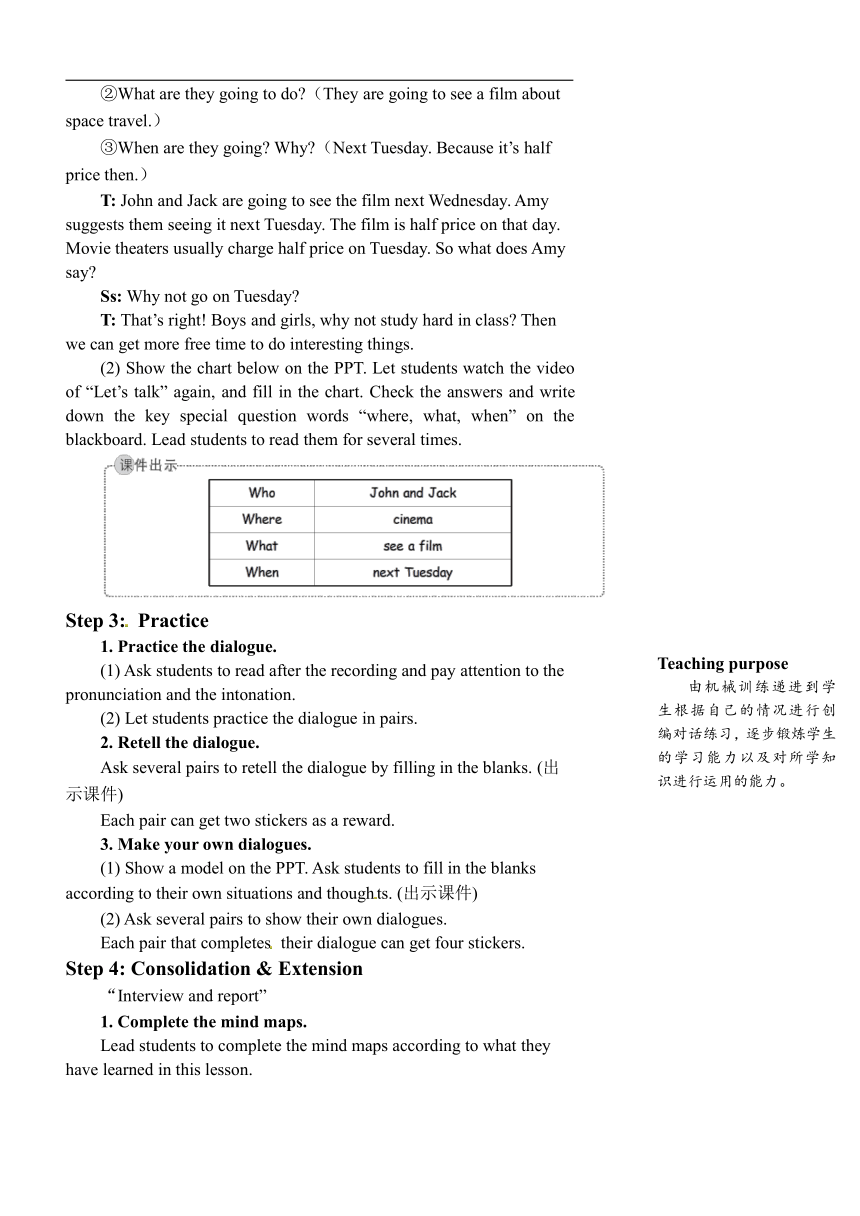Unit 3 My weekend plan Part B Let’s talk教案(含反思,详案与简案)
文档属性
| 名称 | Unit 3 My weekend plan Part B Let’s talk教案(含反思,详案与简案) |  | |
| 格式 | zip | ||
| 文件大小 | 352.1KB | ||
| 资源类型 | 教案 | ||
| 版本资源 | 人教版(PEP) | ||
| 科目 | 英语 | ||
| 更新时间 | 2020-06-12 14:29:12 | ||
图片预览




文档简介
Unit
3
My
weekend
plan
The
third
period
Part
B
Let’s
try
&
Let’s
talk
?教学内容与目标
课时教学内容
课时教学目标
Let’s
try
·能够读懂题目要求,并能在听前预测听力重点内容·能通过完成听力练习预测后续故事·能运用基本听力技巧完成主旨题和细节题
Let’s
talk
·能够理解对话大意,并能够按照正确的意群及语音、语调朗读对话·能够听、说、读、写并在情景中恰当运用句型“—Where
are/is…going?
—…is
going
to…”“When
are/is…going?”谈论计划的时间与地点·通过对话学习了解电影院周二通常有半价电影票的生活常识·能够听、说、认读单词:space,
travel,
half,
price
?教学重点
1.学生能够理解对话大意,并能够按照正确的意群及语音、语调朗读对话。[来源:学,科,网Z,X,X,K]
2.能够听、说、读、写并在情景中恰当运用句型“—Where
are/is…going?
—…is
going
to…”“When
are/is…going?”谈论计划的时间与地点。
?教学难点
能运用what,
where,
when引导的特殊疑问句进行真实的交流。
?教学准备
PPT课件、课文录音、视频、卡片、电影海报、价格标签等。
?教学过程
Step
1:
Warm-up
&
Revision
&
Lead-in
1.
Greetings.
2.
Enjoy
a
song—Where
are
you
going?
(课件出示:本歌曲的视频)
3.
Play
a
game:
Watch
out
for
the
tiger!
Show
the
rules
of
this
game.
Rules:
(游戏说明:PPT以随机的顺序呈现上节课所学的重点单词和词组:this
morning,
this
afternoon,
this
evening,
tonight,
tomorrow,
next
week,
visit
my
grandparents,
see
a
film,
take
a
trip,
go
to
the
supermarket。
在此过程中,一只淘气的老虎会偷偷出现,同学们在看见单词和词组出现的时候大声读出它们,当老虎出现的时候集体用手抱住头部,并大喊:
“Ah!”)
4.
Lead-in.
T:You’ve
done
a
good
job!
Here
is
a
special
apple
and
a
special
ice
cream
for
you!
Do
you
want
to
have
a
look?
Ss:
Yes…
Show
the
pictures
of
“Let’s
try”
on
the
PPT.
(课件出示:教材P26
Let’s
try板块的两幅图片)
Let
students
answer
who
is
in
the
apple
and
who
is
in
the
ice
cream.
Step
2:
Presentation
1.
Listen
and
answer.
T:
John
is
on
his
way
home.
He
sees
Amy.
What
are
they
talking
about?
(1)
Show
the
questions
of
“Let’s
try”
on
the
PPT.
(出示课件)
Let
students
predict
the
answers.
(2)
Then
play
the
recording
of
“Let’s
try”.
(出示课件)
Ask
students
to
catch
the
key
information.
And
ask
them
to
pay
attention
to
the
changes
in
person
and
number.
Then
ask
them
to
answer
the
two
questions.
(3)
Students
read
the
dialogue
and
check
the
answers
with
the
teacher.
(课件出示:教材P26
Let’s
try板块的听力材料及答案)
2.
Find
some
information
from
the
poster.
(1)
Show
a
picture
of
John
and
Jack.
(课件出示:John和Jack的图片)
T:
Look.
He
is
John’s
cousin
Jack.
John
and
Jack
are
going
to
do
something
interesting.
What
are
they
going
to
do?
Please
guess!
Ss:
They
are
going
to…
Encourage
students
to
say
more
possible
activities.
(2)
Let
students
watch
the
poster
of
Travel
to
Mars.
(课件出示:电影《火星之旅》的海报)
And
ask
students
to
try
to
find
the
answer
to
the
question:
What
are
John
and
Jack
going
to
do?
Check
the
answer
together:
They
are
going
to
see
a
film.
Ask
another
question:
What
film
are
they
going
to
see?
Ask
students
to
watch
the
poster
carefully.
Lead
students
to
find
the
answer:
They
are
going
to
see
a
film
about
space
travel.
Write
down
the
key
phrase
“space
travel”
on
the
blackboard.
T:
Do
you
know
what
space
travel
is?
Ss:
…
Play
a
short
video
about
space
travel.
(课件出示:一段关于太空旅行的简短视频)
T:
Do
you
like
the
film
about
space
travel?
Why?
Encourage
students
to
say
their
own
opinions.
Then
lead
students
to
read
the
phrase
“space
travel”
for
three
times.
The
teacher
can
provide
another
question:
What’s
your
favourite
film?
Let
students
discuss
and
answer
it.
(3)T:
Try
to
get
more
information
from
this
poster.
Can
you
say
more
information
about
this
film?
Lead
students
to
find
the
key
phrase
“half
price”.
Use
a
real
half-price
price
tag
to
teach
what
“half
price”
is.
T:
We
usually
see
this
kind
of
price
tag
in
the
supermarkets,
shoe
stores,
clothes
shops
and
every
kind
of
big
or
small
malls.
Who
can
tell
us
what
it
means?
After
students
express
their
explanations,
the
teacher
can
act
as
a
sales
assistant
and
sell
some
things
at
their
half
price
to
students.
Students
need
to
speak
out
the
right
price.
Then
lead
students
to
read
the
phrase
“half
price”
for
three
times.
At
last,
point
to
the
word
“Tuesday”.
T:
When
is
the
film
half
price?
Ss:
It’s
on
Tuesday.
T:
Clever!
3.
Learn
the
dialogue.
(1)T:
We
know
that
the
film
is
half
price
on
Tuesday.
So
when
are
you
going
to
see
it?
Why?
Ss:
I’m
going
to
see
it
on
Tuesday.
Because
it
is
cheap
on
that
day./…
T:
How
about
John
and
Jack?
When
are
they
going
to
see
the
film?
S1:
I
think
they
are
going
to
see
it
on
Tuesday,
too./S2:
I
don’t
think
so…
T:
It
seems
that
we
have
different
opinions.
John
is
talking
with
Amy
about
what
he
is
going
to
do
with
Jack.
Let’s
watch
the
cartoon
of
“Let’s
talk”
to
find
the
answers
to
the
following
questions.
You
can
underline
the
answers
in
the
dialogue.
Let
students
watch
the
video
of
“Let’s
talk”
and
try
to
answer
the
three
questions.
(课件出示:教材P26
Let’s
talk板块的视频)
Then
check
the
answers.
Questions:
①Where
are
they
going?(They
are
going
to
the
cinema.)
②What
are
they
going
to
do?(They
are
going
to
see
a
film
about
space
travel.)
③When
are
they
going?
Why?(Next
Tuesday.
Because
it’s
half
price
then.)
T:
John
and
Jack
are
going
to
see
the
film
next
Wednesday.
Amy
suggests
them
seeing
it
next
Tuesday.
The
film
is
half
price
on
that
day.
Movie
theaters
usually
charge
half
price
on
Tuesday.
So
what
does
Amy
say?
Ss:
Why
not
go
on
Tuesday?
T:
That’s
right!
Boys
and
girls,
why
not
study
hard
in
class?
Then
we
can
get
more
free
time
to
do
interesting
things.
(2)
Show
the
chart
below
on
the
PPT.
Let
students
watch
the
video
of
“Let’s
talk”
again,
and
fill
in
the
chart.
Check
the
answers
and
write
down
the
key
special
question
words
“where,
what,
when”
on
the
blackboard.
Lead
students
to
read
them
for
several
times.
Step
3:
Practice
1.
Practice
the
dialogue.
(1)
Ask
students
to
read
after
the
recording
and
pay
attention
to
the
pronunciation
and
the
intonation.
(2)
Let
students
practice
the
dialogue
in
pairs.
2.
Retell
the
dialogue.
Ask
several
pairs
to
retell
the
dialogue
by
filling
in
the
blanks.
(出示课件)
Each
pair
can
get
two
stickers
as
a
reward.
3.
Make
your
own
dialogues.
(1)
Show
a
model
on
the
PPT.
Ask
students
to
fill
in
the
blanks
according
to
their
own
situations
and
thoughts.
(出示课件)
(2)
Ask
several
pairs
to
show
their
own
dialogues.
Each
pair
that
completes
their
dialogue
can
get
four
stickers.
Step
4:
Consolidation
&
Extension
“Interview
and
report”
1.
Complete
the
mind
maps.
Lead
students
to
complete
the
mind
maps
according
to
what
they
have
learned
in
this
lesson.
2.
Interview
your
classmates.
Show
the
chart
in
the
book.
(课件出示:教材P26
下面表格)
Let
students
ask
and
answer
with
each
other
in
pairs
and
write
down
the
results
in
the
chart.
3.
Show
time.
Ask
students
to
work
in
pairs
to
show
their
dialogue
according
to
the
three
questions
in
the
chart.
Make
a
model:
A:
Where
are
you
going
this
afternoon?
B:
I’m
going
to
the
nature
park.
A:
What
are
you
going
to
do
there?
B:
I’m
going
to
play
basketball.
A:
When
are
you
going?
B:
I’m
going
at
4:30
this
afternoon.
The
best
pair
can
get
five
stickers.
The
second
pair
can
get
three
stickers.
The
third
pair
can
get
one
sticker.
4.
Evaluation.
Count
the
total
stickers
of
each
pair.
Find
the
best
pair.
Give
them
two
film
posters
as
rewards.
?板书设计
?教学反思
1.本课重点是掌握由what、where、when三个特殊疑问词引导的特殊疑问句。因此本课中注重让学生大量地练习对话,并在接近真实的情景里运用对话。
2.在完成听力活动和学习对话之前,让学生对所学内容进行了预测。给出问题,让学生带着问题去听听力、阅读对话,使学生的学习目的明确,因而更加能够集中注意力,主动去探究、去学习。
3.学习词组部分,采取了丰富多样的形式,降低了学习词组的枯燥性,增加了课堂的色彩和活力。
4.拓展环节的思维导图,还有重点句型的展示,为学生进行拓展活动降低了难度,也让学生在完成活动的过程中建立了自信。
?Teaching
Contents
&
Teaching
Aims
Let’s
try
·Be
able
to
understand
the
requirements
of
the
questions
and
predict
the
key
points
before
listening.
·Be
able
to
predict
the
subsequent
story
by
completing
the
listening
exercises.
·Be
able
to
use
basic
listening
skills
to
complete
the
topic
and
the
detail
questions.
Let’s
talk
·Be
able
to
understand
the
main
idea
of
the
dialogue
and
read
the
dialogue
according
to
the
pronunciation,
the
intonation
and
the
correct
sense
group.
·Be
able
to
listen,
speak,
read,
write
and
use
the
sentence
structures
“—Where
are/is…going?
—…is
going
to…”
“When
are/is…going?”
to
talk
about
planned
time
and
place
in
scenes.
·Through
the
dialogue,
get
to
know
that
movie
theaters
usually
offer
half?price
tickets
on
Tuesdays.
·Be
able
to
listen,
speak
and
read
the
words
“space,
travel,
half,
price”.
?Teaching
Priorities
·
Be
able
to
understand
the
main
idea
of
the
dialogue
and
be
able
to
read
the
dialogue
according
to
the
pronunciation,
the
intonation
and
the
correct
sense
group.
·
Be
able
to
listen,
speak,
read,
write
and
use
the
sentence
structures
“—Where
are/is…going?…is
going
to…”
“When
are/is…going?”
to
talk
about
planned
time
and
place
in
scenes.
?Teaching
Difficulties
·
Be
able
to
use
the
sentence
structures
“What…?”
“Where…?”
“When…?”
to
communicate
in
real
situations.
[来源:学科网]
?Teaching
Procedures
Teaching
Stages
Teacher’
s
Activities
Students
Activities
Teaching
Purposes
Warm-up&Revision&Lead-in
1.
Greetings.2.
Enjoy
a
song—Where
are
you
going?
3.
Play
a
game:
Watch
out
for
the
tiger!
4.
Lead-in.Show
the
pictures
of
“Let’s
try”.
Lead
students
to
meet
two
friends.
1.
Greetings.2.
Enjoy
the
song.3.
Play
the
game.
If
they
see
a
word
or
a
phrase,
read
it
out.
If
they
see
a
tiger,
hold
their
heads
and
say
“Ah!”4.
Meet
two
friends
The
song
previews
the
new
knowledge
in
this
lesson.
The
game
makes
students
review
the
words
and
the
phrases
they’ve
learned
in
the
last
lesson
in
a
pleasant
environment.
Presentation
Listen
and
answer.Show
the
questions
of
“Let’s
try”
on
the
PPT.(2)Play
the
recording
of
“Let’s
try”.[来源:学科网](3)
Check
the
answers.
(1)
Predict
and
guess
the
answers.(2)
Listen
and
answer
the
questions.
[来源:学+科+网Z+X+X+K](3)
Pay
attention
to
the
changes
in
person
and
number.
Read
the
dialogue
and
check
the
answers.
Lead
students
to
predict
the
listening
content
before
listening
to
the
recording
with
the
questions.
Diverge
students’
thinking
and
strengthen
their
listening
skill
training.
2.
Find
some
information
from
the
poster.(1)
Show
a
picture
of
John
and
Jack.
Encourage
students
to
say
more
possible
activities.(2)
Use
a
short
video
to
teach
the
phrase
“space
travel”.(3)
Teach
the
phrase
“half
price”.
(1)
Say
more
possible
activities
that
John
and
Jack
are
going
to
do.(2)
Answer
the
teacher’s
questions
and
learn
the
phrase
“space
travel”.Learn
the
phrase
“half
price”.
By
observing
the
film
poster,
answering
the
questions,
watching
the
video
and
other
ways,
try
to
let
students
learn
the
new
phrases
in
an
imperceptibly
way.
3.
Learn
the
dialogue.(1)
Give
students
three
questions.
Play
the
video.(2)
Show
a
chart.Check
the
answers
and
lead
students
to
read
the
key
special
question
words
for
several
times.
(1)
Watch
the
video
of
“Let’s
talk”
and
answer
these
three
questions.(2)
Watch
the
video
again
and
fill
in
the
chart.Check
the
answers
and
read
the
key
special
question
words
for
several
times.
By
solving
the
problems
in
the
forward
direction
and
then
finding
the
problems
in
the
reverse
direction,
students
have
a
deep
understanding
of
the
dialogue.
Cultivate
students’
logical
thinking
ability.
(续表)
Teaching
Stages
Teacher’
s
Activities
Students’
Activities
Teaching
Purposes
Practice
1.
Practice
the
dialogue.Play
the
recording.2.
Retell
the
dialogue.Ask
several
pairs
to
retell
the
dialogue
by
filling
in
the
blanks.3.
Make
your
own
dialogues.Show
a
model
on
the
PPT.
1.
Read
the
dialogue
after
the
recording.
Practice
the
dialogue
in
pairs.2.
Retell
the
dialogue
by
filling
in
the
blanks.3.
Fill
in
the
blanks
according
to
their
own
situations
and
thoughts
and
act
out
their
own
dialogues.
From
mechanical
training
to
replacing
the
key
parts
according
to
students’
situations,
gradually
train
their
learning
ability
and
the
ability
of
using
English.
Consolidation&Extension
“Interview
and
report”1.
Complete
the
mind
maps.2.
Interview
your
classmates.3.
Show
time.4.
Evaluation.Find
the
best
pair
and
reward
them.
1.
Complete
the
mind
maps.
2.
Ask
and
answer
with
each
other
in
pairs
and
write
down
the
results
in
the
chart.3.
Show
their
work
in
pairs.4.
The
winner
pair
can
get
rewards.
Reduce
the
difficulty
of
the
consolidation
and
extension
with
the
help
of
the
mind
maps.
Enable
students
to
use
the
key
sentence
structures
flexibly
and
replace
the
key
words
to
expand,
effectively
achieving
the
learning
aims
of
this
lesson
through
the
interview.
Homework
1.
Practice
the
dialogue.2.
Interview
your
family
members’
plans
for
short
future.
3.
Do
the
exercises.
Teaching
purpose
通过歌曲对本课将要学习的新知进行预热。游戏环节使学生们在一个轻松、愉悦的环境中对上节课所学的词汇进行复习和巩固。
Teaching
purpose
通过问题引导学生在听录音之前先预测听力内容,发散学生的思维,加强对学生的听力技巧的训练。
Teaching
purpose
通过观察电影海报、回答老师的提问、观看视频、运用实物、创设场景等多种方式,尽量让学生在潜移默化中学习新的词组,而不是生搬硬套地让学生去记忆学习。
Teaching
purpose
通过正向解决问题,再反向找出问题的方式,使学生对课本的对话内容有深入的了解,培养学生的逻辑思维能力。
Teaching
purpose
由机械训练递进到学生根据自己的情况进行创编对话练习,逐步锻炼学生的学习能力以及对所学知识进行运用的能力。
Teaching
purpose
在思维导图的帮助下,能够降低拓展环节的难度。学生通过采访进行对话练习,灵活运用本课的重点句型,并能适当替换关键词进行拓展,有效地达到本课的学习目标。
3
My
weekend
plan
The
third
period
Part
B
Let’s
try
&
Let’s
talk
?教学内容与目标
课时教学内容
课时教学目标
Let’s
try
·能够读懂题目要求,并能在听前预测听力重点内容·能通过完成听力练习预测后续故事·能运用基本听力技巧完成主旨题和细节题
Let’s
talk
·能够理解对话大意,并能够按照正确的意群及语音、语调朗读对话·能够听、说、读、写并在情景中恰当运用句型“—Where
are/is…going?
—…is
going
to…”“When
are/is…going?”谈论计划的时间与地点·通过对话学习了解电影院周二通常有半价电影票的生活常识·能够听、说、认读单词:space,
travel,
half,
price
?教学重点
1.学生能够理解对话大意,并能够按照正确的意群及语音、语调朗读对话。[来源:学,科,网Z,X,X,K]
2.能够听、说、读、写并在情景中恰当运用句型“—Where
are/is…going?
—…is
going
to…”“When
are/is…going?”谈论计划的时间与地点。
?教学难点
能运用what,
where,
when引导的特殊疑问句进行真实的交流。
?教学准备
PPT课件、课文录音、视频、卡片、电影海报、价格标签等。
?教学过程
Step
1:
Warm-up
&
Revision
&
Lead-in
1.
Greetings.
2.
Enjoy
a
song—Where
are
you
going?
(课件出示:本歌曲的视频)
3.
Play
a
game:
Watch
out
for
the
tiger!
Show
the
rules
of
this
game.
Rules:
(游戏说明:PPT以随机的顺序呈现上节课所学的重点单词和词组:this
morning,
this
afternoon,
this
evening,
tonight,
tomorrow,
next
week,
visit
my
grandparents,
see
a
film,
take
a
trip,
go
to
the
supermarket。
在此过程中,一只淘气的老虎会偷偷出现,同学们在看见单词和词组出现的时候大声读出它们,当老虎出现的时候集体用手抱住头部,并大喊:
“Ah!”)
4.
Lead-in.
T:You’ve
done
a
good
job!
Here
is
a
special
apple
and
a
special
ice
cream
for
you!
Do
you
want
to
have
a
look?
Ss:
Yes…
Show
the
pictures
of
“Let’s
try”
on
the
PPT.
(课件出示:教材P26
Let’s
try板块的两幅图片)
Let
students
answer
who
is
in
the
apple
and
who
is
in
the
ice
cream.
Step
2:
Presentation
1.
Listen
and
answer.
T:
John
is
on
his
way
home.
He
sees
Amy.
What
are
they
talking
about?
(1)
Show
the
questions
of
“Let’s
try”
on
the
PPT.
(出示课件)
Let
students
predict
the
answers.
(2)
Then
play
the
recording
of
“Let’s
try”.
(出示课件)
Ask
students
to
catch
the
key
information.
And
ask
them
to
pay
attention
to
the
changes
in
person
and
number.
Then
ask
them
to
answer
the
two
questions.
(3)
Students
read
the
dialogue
and
check
the
answers
with
the
teacher.
(课件出示:教材P26
Let’s
try板块的听力材料及答案)
2.
Find
some
information
from
the
poster.
(1)
Show
a
picture
of
John
and
Jack.
(课件出示:John和Jack的图片)
T:
Look.
He
is
John’s
cousin
Jack.
John
and
Jack
are
going
to
do
something
interesting.
What
are
they
going
to
do?
Please
guess!
Ss:
They
are
going
to…
Encourage
students
to
say
more
possible
activities.
(2)
Let
students
watch
the
poster
of
Travel
to
Mars.
(课件出示:电影《火星之旅》的海报)
And
ask
students
to
try
to
find
the
answer
to
the
question:
What
are
John
and
Jack
going
to
do?
Check
the
answer
together:
They
are
going
to
see
a
film.
Ask
another
question:
What
film
are
they
going
to
see?
Ask
students
to
watch
the
poster
carefully.
Lead
students
to
find
the
answer:
They
are
going
to
see
a
film
about
space
travel.
Write
down
the
key
phrase
“space
travel”
on
the
blackboard.
T:
Do
you
know
what
space
travel
is?
Ss:
…
Play
a
short
video
about
space
travel.
(课件出示:一段关于太空旅行的简短视频)
T:
Do
you
like
the
film
about
space
travel?
Why?
Encourage
students
to
say
their
own
opinions.
Then
lead
students
to
read
the
phrase
“space
travel”
for
three
times.
The
teacher
can
provide
another
question:
What’s
your
favourite
film?
Let
students
discuss
and
answer
it.
(3)T:
Try
to
get
more
information
from
this
poster.
Can
you
say
more
information
about
this
film?
Lead
students
to
find
the
key
phrase
“half
price”.
Use
a
real
half-price
price
tag
to
teach
what
“half
price”
is.
T:
We
usually
see
this
kind
of
price
tag
in
the
supermarkets,
shoe
stores,
clothes
shops
and
every
kind
of
big
or
small
malls.
Who
can
tell
us
what
it
means?
After
students
express
their
explanations,
the
teacher
can
act
as
a
sales
assistant
and
sell
some
things
at
their
half
price
to
students.
Students
need
to
speak
out
the
right
price.
Then
lead
students
to
read
the
phrase
“half
price”
for
three
times.
At
last,
point
to
the
word
“Tuesday”.
T:
When
is
the
film
half
price?
Ss:
It’s
on
Tuesday.
T:
Clever!
3.
Learn
the
dialogue.
(1)T:
We
know
that
the
film
is
half
price
on
Tuesday.
So
when
are
you
going
to
see
it?
Why?
Ss:
I’m
going
to
see
it
on
Tuesday.
Because
it
is
cheap
on
that
day./…
T:
How
about
John
and
Jack?
When
are
they
going
to
see
the
film?
S1:
I
think
they
are
going
to
see
it
on
Tuesday,
too./S2:
I
don’t
think
so…
T:
It
seems
that
we
have
different
opinions.
John
is
talking
with
Amy
about
what
he
is
going
to
do
with
Jack.
Let’s
watch
the
cartoon
of
“Let’s
talk”
to
find
the
answers
to
the
following
questions.
You
can
underline
the
answers
in
the
dialogue.
Let
students
watch
the
video
of
“Let’s
talk”
and
try
to
answer
the
three
questions.
(课件出示:教材P26
Let’s
talk板块的视频)
Then
check
the
answers.
Questions:
①Where
are
they
going?(They
are
going
to
the
cinema.)
②What
are
they
going
to
do?(They
are
going
to
see
a
film
about
space
travel.)
③When
are
they
going?
Why?(Next
Tuesday.
Because
it’s
half
price
then.)
T:
John
and
Jack
are
going
to
see
the
film
next
Wednesday.
Amy
suggests
them
seeing
it
next
Tuesday.
The
film
is
half
price
on
that
day.
Movie
theaters
usually
charge
half
price
on
Tuesday.
So
what
does
Amy
say?
Ss:
Why
not
go
on
Tuesday?
T:
That’s
right!
Boys
and
girls,
why
not
study
hard
in
class?
Then
we
can
get
more
free
time
to
do
interesting
things.
(2)
Show
the
chart
below
on
the
PPT.
Let
students
watch
the
video
of
“Let’s
talk”
again,
and
fill
in
the
chart.
Check
the
answers
and
write
down
the
key
special
question
words
“where,
what,
when”
on
the
blackboard.
Lead
students
to
read
them
for
several
times.
Step
3:
Practice
1.
Practice
the
dialogue.
(1)
Ask
students
to
read
after
the
recording
and
pay
attention
to
the
pronunciation
and
the
intonation.
(2)
Let
students
practice
the
dialogue
in
pairs.
2.
Retell
the
dialogue.
Ask
several
pairs
to
retell
the
dialogue
by
filling
in
the
blanks.
(出示课件)
Each
pair
can
get
two
stickers
as
a
reward.
3.
Make
your
own
dialogues.
(1)
Show
a
model
on
the
PPT.
Ask
students
to
fill
in
the
blanks
according
to
their
own
situations
and
thoughts.
(出示课件)
(2)
Ask
several
pairs
to
show
their
own
dialogues.
Each
pair
that
completes
their
dialogue
can
get
four
stickers.
Step
4:
Consolidation
&
Extension
“Interview
and
report”
1.
Complete
the
mind
maps.
Lead
students
to
complete
the
mind
maps
according
to
what
they
have
learned
in
this
lesson.
2.
Interview
your
classmates.
Show
the
chart
in
the
book.
(课件出示:教材P26
下面表格)
Let
students
ask
and
answer
with
each
other
in
pairs
and
write
down
the
results
in
the
chart.
3.
Show
time.
Ask
students
to
work
in
pairs
to
show
their
dialogue
according
to
the
three
questions
in
the
chart.
Make
a
model:
A:
Where
are
you
going
this
afternoon?
B:
I’m
going
to
the
nature
park.
A:
What
are
you
going
to
do
there?
B:
I’m
going
to
play
basketball.
A:
When
are
you
going?
B:
I’m
going
at
4:30
this
afternoon.
The
best
pair
can
get
five
stickers.
The
second
pair
can
get
three
stickers.
The
third
pair
can
get
one
sticker.
4.
Evaluation.
Count
the
total
stickers
of
each
pair.
Find
the
best
pair.
Give
them
two
film
posters
as
rewards.
?板书设计
?教学反思
1.本课重点是掌握由what、where、when三个特殊疑问词引导的特殊疑问句。因此本课中注重让学生大量地练习对话,并在接近真实的情景里运用对话。
2.在完成听力活动和学习对话之前,让学生对所学内容进行了预测。给出问题,让学生带着问题去听听力、阅读对话,使学生的学习目的明确,因而更加能够集中注意力,主动去探究、去学习。
3.学习词组部分,采取了丰富多样的形式,降低了学习词组的枯燥性,增加了课堂的色彩和活力。
4.拓展环节的思维导图,还有重点句型的展示,为学生进行拓展活动降低了难度,也让学生在完成活动的过程中建立了自信。
?Teaching
Contents
&
Teaching
Aims
Let’s
try
·Be
able
to
understand
the
requirements
of
the
questions
and
predict
the
key
points
before
listening.
·Be
able
to
predict
the
subsequent
story
by
completing
the
listening
exercises.
·Be
able
to
use
basic
listening
skills
to
complete
the
topic
and
the
detail
questions.
Let’s
talk
·Be
able
to
understand
the
main
idea
of
the
dialogue
and
read
the
dialogue
according
to
the
pronunciation,
the
intonation
and
the
correct
sense
group.
·Be
able
to
listen,
speak,
read,
write
and
use
the
sentence
structures
“—Where
are/is…going?
—…is
going
to…”
“When
are/is…going?”
to
talk
about
planned
time
and
place
in
scenes.
·Through
the
dialogue,
get
to
know
that
movie
theaters
usually
offer
half?price
tickets
on
Tuesdays.
·Be
able
to
listen,
speak
and
read
the
words
“space,
travel,
half,
price”.
?Teaching
Priorities
·
Be
able
to
understand
the
main
idea
of
the
dialogue
and
be
able
to
read
the
dialogue
according
to
the
pronunciation,
the
intonation
and
the
correct
sense
group.
·
Be
able
to
listen,
speak,
read,
write
and
use
the
sentence
structures
“—Where
are/is…going?…is
going
to…”
“When
are/is…going?”
to
talk
about
planned
time
and
place
in
scenes.
?Teaching
Difficulties
·
Be
able
to
use
the
sentence
structures
“What…?”
“Where…?”
“When…?”
to
communicate
in
real
situations.
[来源:学科网]
?Teaching
Procedures
Teaching
Stages
Teacher’
s
Activities
Students
Activities
Teaching
Purposes
Warm-up&Revision&Lead-in
1.
Greetings.2.
Enjoy
a
song—Where
are
you
going?
3.
Play
a
game:
Watch
out
for
the
tiger!
4.
Lead-in.Show
the
pictures
of
“Let’s
try”.
Lead
students
to
meet
two
friends.
1.
Greetings.2.
Enjoy
the
song.3.
Play
the
game.
If
they
see
a
word
or
a
phrase,
read
it
out.
If
they
see
a
tiger,
hold
their
heads
and
say
“Ah!”4.
Meet
two
friends
The
song
previews
the
new
knowledge
in
this
lesson.
The
game
makes
students
review
the
words
and
the
phrases
they’ve
learned
in
the
last
lesson
in
a
pleasant
environment.
Presentation
Listen
and
answer.Show
the
questions
of
“Let’s
try”
on
the
PPT.(2)Play
the
recording
of
“Let’s
try”.[来源:学科网](3)
Check
the
answers.
(1)
Predict
and
guess
the
answers.(2)
Listen
and
answer
the
questions.
[来源:学+科+网Z+X+X+K](3)
Pay
attention
to
the
changes
in
person
and
number.
Read
the
dialogue
and
check
the
answers.
Lead
students
to
predict
the
listening
content
before
listening
to
the
recording
with
the
questions.
Diverge
students’
thinking
and
strengthen
their
listening
skill
training.
2.
Find
some
information
from
the
poster.(1)
Show
a
picture
of
John
and
Jack.
Encourage
students
to
say
more
possible
activities.(2)
Use
a
short
video
to
teach
the
phrase
“space
travel”.(3)
Teach
the
phrase
“half
price”.
(1)
Say
more
possible
activities
that
John
and
Jack
are
going
to
do.(2)
Answer
the
teacher’s
questions
and
learn
the
phrase
“space
travel”.Learn
the
phrase
“half
price”.
By
observing
the
film
poster,
answering
the
questions,
watching
the
video
and
other
ways,
try
to
let
students
learn
the
new
phrases
in
an
imperceptibly
way.
3.
Learn
the
dialogue.(1)
Give
students
three
questions.
Play
the
video.(2)
Show
a
chart.Check
the
answers
and
lead
students
to
read
the
key
special
question
words
for
several
times.
(1)
Watch
the
video
of
“Let’s
talk”
and
answer
these
three
questions.(2)
Watch
the
video
again
and
fill
in
the
chart.Check
the
answers
and
read
the
key
special
question
words
for
several
times.
By
solving
the
problems
in
the
forward
direction
and
then
finding
the
problems
in
the
reverse
direction,
students
have
a
deep
understanding
of
the
dialogue.
Cultivate
students’
logical
thinking
ability.
(续表)
Teaching
Stages
Teacher’
s
Activities
Students’
Activities
Teaching
Purposes
Practice
1.
Practice
the
dialogue.Play
the
recording.2.
Retell
the
dialogue.Ask
several
pairs
to
retell
the
dialogue
by
filling
in
the
blanks.3.
Make
your
own
dialogues.Show
a
model
on
the
PPT.
1.
Read
the
dialogue
after
the
recording.
Practice
the
dialogue
in
pairs.2.
Retell
the
dialogue
by
filling
in
the
blanks.3.
Fill
in
the
blanks
according
to
their
own
situations
and
thoughts
and
act
out
their
own
dialogues.
From
mechanical
training
to
replacing
the
key
parts
according
to
students’
situations,
gradually
train
their
learning
ability
and
the
ability
of
using
English.
Consolidation&Extension
“Interview
and
report”1.
Complete
the
mind
maps.2.
Interview
your
classmates.3.
Show
time.4.
Evaluation.Find
the
best
pair
and
reward
them.
1.
Complete
the
mind
maps.
2.
Ask
and
answer
with
each
other
in
pairs
and
write
down
the
results
in
the
chart.3.
Show
their
work
in
pairs.4.
The
winner
pair
can
get
rewards.
Reduce
the
difficulty
of
the
consolidation
and
extension
with
the
help
of
the
mind
maps.
Enable
students
to
use
the
key
sentence
structures
flexibly
and
replace
the
key
words
to
expand,
effectively
achieving
the
learning
aims
of
this
lesson
through
the
interview.
Homework
1.
Practice
the
dialogue.2.
Interview
your
family
members’
plans
for
short
future.
3.
Do
the
exercises.
Teaching
purpose
通过歌曲对本课将要学习的新知进行预热。游戏环节使学生们在一个轻松、愉悦的环境中对上节课所学的词汇进行复习和巩固。
Teaching
purpose
通过问题引导学生在听录音之前先预测听力内容,发散学生的思维,加强对学生的听力技巧的训练。
Teaching
purpose
通过观察电影海报、回答老师的提问、观看视频、运用实物、创设场景等多种方式,尽量让学生在潜移默化中学习新的词组,而不是生搬硬套地让学生去记忆学习。
Teaching
purpose
通过正向解决问题,再反向找出问题的方式,使学生对课本的对话内容有深入的了解,培养学生的逻辑思维能力。
Teaching
purpose
由机械训练递进到学生根据自己的情况进行创编对话练习,逐步锻炼学生的学习能力以及对所学知识进行运用的能力。
Teaching
purpose
在思维导图的帮助下,能够降低拓展环节的难度。学生通过采访进行对话练习,灵活运用本课的重点句型,并能适当替换关键词进行拓展,有效地达到本课的学习目标。
同课章节目录
